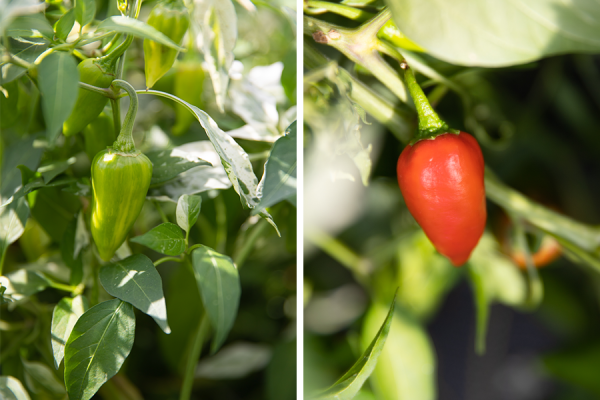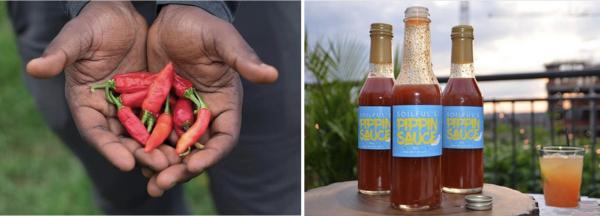Fish peppers: an heirloom vegetable's past and future
Originally posted October 22, 2020.
While all seeds have stories to tell, the fish pepper’s is a novel!
This year, Chef John Patterson asked the Market Garden to grow this heirloom hot pepper variety. It is known for its fruit, which changes many colors as it ripens, for its green and white foliage, and for a culinary “heat” that falls somewhere between cayenne and serrano.
A Philadelphia native, John had been introduced to the fish pepper while at Fork and had learned of its connection to the African-American culture of the Mid Atlantic. He was eager to bring this pepper to the Green Mountain State and into dishes at Shelburne Farms. We are now a tiny footnote in the fish pepper’s long layered story--a story that has a lot to say about heirloom seed saving and our modern agricultural system.
The Fish Pepper’s Migration
Although it’s unclear how fish peppers landed in the Mid Atlantic region, hot peppers from Mexico likely made their way to the Caribbean via trade networks between Africa, Europe and the Americas by at least 1800. Michael Twitty, culinary historian and author of the James Beard Award-winning book, The Cooking Gene, claims that there is a good chance the fish pepper was brought to the Chesapeake region by Haitians around the time of the island’s revolution (1791-1804). The pepper eventually made its way into the vibrant produce markets near Baltimore’s thriving ports, and into the truck farming industry--a critical livelihood for the large free Black population in the area before the Civil War. Those markets also catered to the seafood industry.
Cultural and Culinary Uses
Throughout the Mid Atlantic, fish peppers were likely grown almost exclusively by enslaved African-Americans, freedmen, and farmers. Peppers were used to ease joint pain, treat intestinal worms, deter bugs from tobacco plants, and spice up bland diets. Enslaved people seeking freedom would rub peppers on their feet to try and throw off the bloodhounds on their trails. On plantations, the enslaved could earn money -- maybe even freedom -- by tending vegetable patches and selling produce such as fish peppers.
By 1900, long before Old Bay was crowned Baltimore’s king seasoning for fish, the fish pepper offered its invisible heat to the white sauces that accompanied seafood dishes, giving the plant its name and notoriety. Cooks of the time combined the Afro-Caribbean fish pepper and other ingredients with European and Native American traditions. Twitty writes that the Chesapeake was the first major place of triple Creole heritage--African, Native American and European--a century ahead of New Orleans. With the busy ports of Baltimore welcoming so many immigrants and travelers, the convergence isn’t surprising.
Cookbooks of the time feature recipes for crab gumbo with okra, terrapin stew, and Baltimore oyster pie. Harry Franklyn Hall, a Black chef in Philadelphia and author of 300 Ways to Cook and Serve Shellfish, Terrapin, and Green Turtle (1901), was also a fish pepper devotee. (His book is now highly regarded by food historians.) While never naming the fish pepper outright, he called for hot peppers in many of his dishes. The fish pepper seeds and the recipes were shared by oral tradition and held tightly by the African American Community.
In the early 20th century, many African Americans began to trade farming for more urban opportunities, scrubbing the soil off their hands, and with it the stigma of slave work. The waters of the Chesapeake also began suffering from pollution and overfishing, closing many of the fish houses. As a result, the fish pepper nearly disappeared.
Saved from Obscurity
This heirloom pepper would be lost to us today if not for the perseverance of African American gardeners, and an unlikely interracial friendship between beekeeper H. Ralph Weaver and artist Horace Pippin. During the Great Depression, Weaver began to feed his family from a one-acre plot and developed a passion for rare plant varieties. By the 1940s, he had a bountiful kitchen garden from the seeds he had acquired from his Dutch community.
Pippin, from West Chester, Pennsylvania, suffered from arthritis due to a WWI injury and in the early 1940s, he sought out a popular folk remedy, bee stings. He befriended Weaver and began to barter seeds for bee stings. Weaver acquired seeds from Pippin’s African American community that are now considered rare and culturally significant. The fish pepper was one of them.
Weaver stored his seeds in baby food jars at the bottom of a chest freezer. In 1966, ten years after his death, they were discovered by his grandson, William Roys Weaver. William used those seeds to recultivate most of his grandfather's original garden, and today, he maintains the Roughwood Seed Collection started by his grandfather. With over 4,000 varieties of Pennsylvania’s heritage food plants, it is the oldest collection of seeds in Pennsylvania and the largest private holding of Native American food plants anywhere. In 1995, Weaver offered fish pepper seeds to the public for the first time in the Seed Savers Exchange Yearbook. Since then, the fish pepper has been designated by Slow Food as an outstandingly tasty, culturally important, and endangered heirloom from Philadelphia and Baltimore, and is listed in their Ark of Taste, an international catalog listing heritage plants at risk of being endangered.
Fish Pepper Today
The fish pepper has been popping up in kitchens and gardens in the Chesapeake region again thanks to chefs turning to heirloom vegetables and to African American growers. These farmers are connecting to the pepper’s history, seeking ways to reclaim ancestral ways of working with the land, and sharing their knowledge with the next generation by working with children and schools. Xavier Brown, a D.C.-based urban farmer and founder of Soilful City, now saves Soilful City fish pepper seeds and partners with other Black farmers in his area to grow them. He makes a chili sauce he calls Pippin Sauce, paying homage to the man who helped save many African American heritage plants. In 2008, Denzel Mitchell started Five Seeds Farm and Apiary on vacant lots in Baltimore. Now, its expanded operations north of the city grow heritage varieties rooted in the Mid Atlantic, and Mitchell exclusively sells his fish peppers to his friend and local chef at Woodbury Kitchen, Spike Gjerde. Mitchell also manages the farm and garden at the Baltimore Montessori Public Charter School, where he teaches gardening, cooking and healthy-eating skills.
Seed Saving
In the 1930s and 40s it was common for home gardeners to save seeds. Whether for frugality or self reliance, the practice has helped preserve cultures and biodiversity, as the story of the fish pepper shows. That practice has become harder since then, as various federal laws now grant full patent protection to commercially developed seed varieties. Today, four companies control more than 60% of global seed sales, and farmers and breeders cannot save these seeds to breed new plant varieties.
As more people and communities seek to grow their own food like their grandparents and great grandparents did, seed saving is the next natural step to food sovereignty and a deeper connection to the food we eat. Since 1975, The Seed Savers Exchange has saved and shared heirloom seeds and led a movement to protect biodiversity and heirloom varieties. They have the largest collection of seeds in America with some 20,000+ varieties! They rely on gardeners to grow and share their seeds, and have outlined simple steps on how to save seeds to help any novice seed saver.
Back here at Shelburne Farms, the Market Garden continues to grow fish peppers. You can order them directly from our Farm Store, or look for them pickled in a hot sauce that Chef John has in the works. Either way, you can think back on the long, living history of the fish pepper.
Further reading and resources:
- Slow Food
- Seed Savers Exchange
- Southern Foodways Alliance
- Afroculinaria
- Southern Exposure Seed Exchange
- Indigenous Seed Keepers Network


